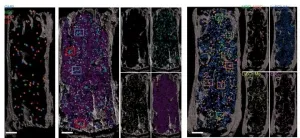Researchers unravel what makes someone a COVID-19 super-spreader
Age, BMI and degree of COVID-19 infection combine to make someone more likely to breathe out more respiratory droplets -- key spreaders of SARS-CoV-2
2021-02-10
(Press-News.org) Scientists and public health experts have long known that certain individuals, termed "super-spreaders," can transmit COVID-19 with incredible efficiency and devastating consequences.
Now, researchers at Tulane University, Harvard University, MIT and Massachusetts General Hospital have learned that obesity, age and COVID-19 infection correlate with a propensity to breathe out more respiratory droplets -- key spreaders of SARS-CoV-2, the virus that causes COVID-19. Their findings were published in Proceedings of the National Academy of Sciences.
Using data from an observational study of 194 healthy people and an experimental study of nonhuman primates with COVID-19, researchers found that exhaled aerosol particles vary greatly between subjects. Those who were older with higher body mass indexes (BMI) and an increasing degree of COVID-19 infection had three times the number of exhaled respiratory droplets as others in the study groups.
Researchers found that 18% of the human subjects accounted for 80% of the exhaled particles of the group, reflecting a distribution of exhaled aerosol particles that follows the 20/80 rule seen in other infectious disease epidemics - meaning 20% of infected individuals are responsible for 80% of transmissions.
Aerosol droplets in nonhuman primates increased as infection with COVID-19 progressed, reaching peak levels a week after infection before falling to normal after two weeks. Notably, as infection with COVID-19 progressed, viral particles got smaller, reaching the size of a single micron at the peak of infection. Tiny particles are more likely to be expelled as people breathe, talk or cough. They can also stay afloat much longer, travel farther in the air and penetrate deeper into the lungs when inhaled.
The increase in exhaled aerosols occurred even among those with asymptomatic cases of COVID-19, said Chad Roy, PhD, corresponding author and director of infectious disease aerobiology at the Tulane National Primate Research Center.
"We've seen a similar increase in droplets during the acute infection stage with other infectious diseases like tuberculosis," Roy said. "It seems likely that viral and bacterial infections of the airway can weaken airway mucus, which promotes the movement of infectious particles into this environment."
The generation of respiratory drops in the airways varies between people depending on their body composition, said lead author David Edwards, PhD, professor of the practice of biomedical engineering at Harvard University.
"While our results show that the young and healthy tend to generate far fewer droplets than the older and less healthy, they also show that any of us, when infected by COVID-19, may be at risk of producing a large number of respiratory droplets," Edwards said.
INFORMATION:
ELSE PRESS RELEASES FROM THIS DATE:
2021-02-10
(New York, NY) February 10, 2021 - A research team led by the Icahn School of Medicine at Mount Sinai (Icahn Mount Sinai) has built the first cellular model to depict the evolution of acute myeloid leukemia (AML), from its early to late stages. By using gene editing technologies to alter genes that make cells malignant, the team was able to identify potential therapeutic targets for early disease stages. The study was reported in the journal Cell Stem Cell in February.
The therapeutic targets could be applicable not just to AML but also to the blood cancer myelodysplastic syndrome and clonal hematopoiesis, which is often a preleukemic condition.
"We essentially built from scratch a model of leukemia that characterizes the ...
2021-02-10
Global emissions of a potent substance notorious for depleting the Earth's ozone layer - the protective barrier which absorbs the Sun's harmful UV rays - have fallen rapidly and are now back on the decline, according to new research.
Two international studies published today in Nature, show emissions of CFC-11, one of the many chlorofluorocarbon (CFC) chemicals once widely used in refrigerators and insulating foams, are back on the decline less than two years after the exposure of their shock resurgence in the wake of suspected rogue production.
Dr Luke Western, from the University of Bristol, a co-lead author of one ...
2021-02-10
When we tear a muscle " stem cells within it repair the problem. We can see this occurring not only in severe muscle wasting diseases such as muscular dystrophy and in war veterans who survive catastrophic limb injuries, but also in our day to day lives when we pull a muscle.
Also when we age and become frail we lose much of our muscle and our stem cells don't seem to be able to work as well as we age.
These muscle stem cells are invisible engines that drive the tissue's growth and repair after such injuries. But growing these cells in the lab and then using them to therapeutically replace damaged muscle has been frustratingly difficult.
Researchers at the Australian Regenerative Medicine Institute at Monash University in Melbourne, ...
2021-02-10
Researchers at the Centre for Genomic Regulation (CRG) reveal that newly formed embryos clear dying cells to maximise their chances of survival. It is the earliest display of an innate immune response found in vertebrate animals to date.
The findings, which are published today in the journal Nature, may aid future efforts to understand why some embryos fail to form in the earliest stages of development, and lead to new clinical efforts in treating infertility or early miscarriages.
An embryo is fragile in the first hours after its formation. Rapid cell division and environmental stress make them prone to cellular errors, which in turn cause the sporadic death of embryonic stem cells. This is ...
2021-02-10
For nearly a century, scientists have worked to unravel the mystery of dark matter--an elusive substance that spreads through the universe and likely makes up much of its mass, but has so far proven impossible to detect in experiments. Now, a team of researchers have used an innovative technique called "quantum squeezing" to dramatically speed up the search for one candidate for dark matter in the lab.
The findings, published today in the journal Nature, center on an incredibly lightweight and as-of-yet undiscovered particle called the axion. According to theory, axions are likely billions to trillions of times smaller than electrons and may have been created during the Big Bang in humungous numbers--enough ...
2021-02-10
What The Study Did: This observational study describes differences in the number of COVID-19 deaths by nursing home racial composition and examines the factors associated with these differences.
Authors: Rebecca J. Gorges, Ph.D., of the University of Chicago, is the corresponding author.
To access the embargoed study: Visit our For The Media website at this link https://media.jamanetwork.com/
(doi:10.1001/jamanetworkopen.2020.37431)
Editor's Note: The article includes funding/support disclosures. Please see the article for additional information, including other authors, author contributions and affiliations, conflict of interest ...
2021-02-10
What The Study Did: This article revisits the role of dermatologists in the early HIV/AIDS epidemic for the 40th anniversary of the epidemic.
Authors: Heather Milbar, M.D., M.P.H., of the University of Pennsylvania in Philadelphia, is the corresponding author.
To access the embargoed study: Visit our For The Media website at this link https://media.jamanetwork.com/
(doi:10.1001/jamadermatol.2020.5545)
Editor's Note: Please see the article for additional information, including other authors, author contributions and affiliations, conflict of interest and financial disclosures, and funding and support.
INFORMATION:
Media ...
2021-02-10
What The Study Did: Researchers examined changes in how organ donation from deceased donors differed by race and ethnicity in the United States over time.
Authors: Dorry L. Segev, M.D., Ph.D., of the Johns Hopkins University School of Medicine in Baltimore, is the corresponding author.
To access the embargoed study: Visit our For The Media website at this link https://media.jamanetwork.com/
(doi:10.1001/jamasurg.2020.7083)
Editor's Note: The article includes conflicts of interest and funding/support disclosures. Please see the article for additional information, including other authors, author contributions and affiliations, conflict of interest and financial disclosures, and funding and support.
INFORMATION:
Media advisory: The full study is linked to this news ...
2021-02-10
Researchers in Southampton and San Francisco have developed the first compact 3D LiDAR imaging system that can match and exceed the performance and accuracy of most advanced, mechanical systems currently used.
3D LiDAR can provide accurate imaging and mapping for many applications; it is the "eyes" for autonomous cars and is used in facial recognition software and by autonomous robots and drones. Accurate imaging is essential for machines to map and interact with the physical world but the size and costs of the technology currently needed has limited LIDAR's use in ...
2021-02-10
CINCINNATI--Imagine a day when clinicians treating people with blood diseases such as leukemia or multiple myeloma can send in requests for laboratories to custom-produce specific types of blood cells to replace those affected by the disease.
That day became one step closer to reality with a new study led by experts at Cincinnati Children's that provides powerful new insights into how bone marrow tissue works.
The study, published Feb. 10, 2021 in Nature, was led by senior author Daniel Lucas, PhD, and first authors Jizhou Zhang, MD, and Qingqing Wu, PhD, from the Division of Experimental Hematology and Cancer Biology. Co-authors include a team of scientists from Cincinnati Children's and the University of Cincinnati, plus collaborators in Colorado, Texas and Michigan.
The ...
LAST 30 PRESS RELEASES:
[Press-News.org] Researchers unravel what makes someone a COVID-19 super-spreader
Age, BMI and degree of COVID-19 infection combine to make someone more likely to breathe out more respiratory droplets -- key spreaders of SARS-CoV-2


